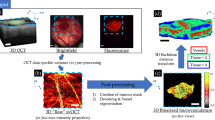Abstract
Purpose:
The aim of the present study was to evaluate and quantify the antiangiogenetic effect of ionizing radiation on tumor angiogenesis using digital subtraction angiography (DSA) in conjunction with computer assisted image analysis (CAIA).
Methods:
Walker 256 carcinosarcoma was inoculated in both glutei of 12 Wistar rats. When the tumors reached a diameter of 1.5 cm, local irradiation of the right gluteus was performed. The left gluteus of each animal served as a control. After 24 hours of irradiation, angiography was performed, and images where digitized and subsequently processed. The effect of irradiation was observed both in big and small vessels (smaller or greater than 200 μm).
Results:
Irradiated areas of both small and big vessels showed a statistically significant reduction in both total vessel area and length. Small vessels showed a greater trend toward suppression by irradiation (not statistically significant).
Conclusion:
Irradiation had a deleterious effect in both macro- and micro-blood supply of a tumor. The use of CAIA enhanced the efficacy of DSA and enabled the in vivo identification of the effect of irradiation on various caliber vessels as well as the ratios of total length and total area of small and big vessels.
Similar content being viewed by others
References
Doyle JW, Li Y-Q and Salloum A (1996). The effects of radiation on neovascularization in a rat model. Plast Reconstr Surg 98: 129–135
Karnabatidis D, Dimopoulos JC and Siablis D (2001). Quantification of the ionising radiation effect over angiogenesis in the chick embryo and its chorioallantoic membrane by computerised analysis of angiographic images. Acta Radiol 42: 333–338
Folkman J (1996). New perspectives in clinical oncology from angiogenesis research. Eur J Cancer 32A: 2534
Hatjikondi O, Ravazoula P and Kardamakis D (1996). in vivo experimental evidence that the nitric oxide pathway is involved in the X-ray-induced anti-angiogenicity. Br J Cancer 74: 1916–1923
Nikiforidis G, Papazafiropoulos D and Siamblis D (1999). Quantitative assessment of angiogenesis in the chick embryo and its chorioallantoic membrane by computerised analysis of angiographic images. Eur J Radiol 29: 168–179
Ribatti D, Vacca A, Roncali L and Dammacco F (1991). Angiogenesis under normal and pathological conditions. Haematologica 76: 311–320
Siamblis D, Karnabatidis D and Hatjikondi O (1996). A novel radiological approach for the experimental study of angiogenesis. Angiography of the chick embryo and its chorioallantoic membrane. Eur J Radiol 21: 220–224
Ebbinghaus SW and Gordon MS (2004). Renal cell carcinoma: rationale and development of therapeutic inhibitors of angiogenesis. Hematol Oncol Clin North Am 18: 1143–1159
Michaelson MD and Smith MR (2003). Genitourinary malignancies. Cancer Chemother Biol Response Modif 21: 547–564
Beecken WD, Bentas W and Glienke W (2002). Serum angiogenic activity: diagnostic relevance in renal cell carcinoma. Eur Urol 42: 364–369
Wechsel HW, Bichler KH and Feil G (1999). Renal cell carcinoma: relevance of angiogenetic factors. Anticancer Res 19(2C): 1537–1540
Skutta B, Furst G and Eilers J (1999). Intracranial stenoocclusive disease: double-detector helical CT angiography versus digital subtraction angiography. AJNR 20: 791–779
Kaatee R, Beek FJ and de Lange EE (1997). Renal artery stenosis: detection and quantification with spiral CT angiography versus optimized digital subtraction angiography. Radiology 205: 121–127
Fishman EK (2001). CT angiography: clinical applications in the abdomen. RadioGraphics 21(suppl): S3–S16
Kim KI, Muller NL and Mayo JR (1999). Clinically suspected pulmonary embolism: utility of spiral CT. Radiology 210: 693–697
Author information
Authors and Affiliations
Corresponding author
Rights and permissions
About this article
Cite this article
Siablis, D., Liatsikos, E.N., Karnabatidis, D. et al. Digital subtraction angiography and computer assisted image analysis for the evaluation of the antiangiogenetic effect of ionizing radiation on tumor angiogenesis. Int Urol Nephrol 38, 407–411 (2006). https://doi.org/10.1007/s11255-005-3617-3
Published:
Issue Date:
DOI: https://doi.org/10.1007/s11255-005-3617-3




